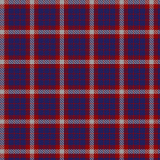Tartan of the U.S. Coast Guard

When one thinks of Scotland, many iconic images come to mind; rolling green hills, ancient castles, and Nessie swimming in her loch. Even more memorable than these, however, is the patterned fabric which has come to symbolize Scottish culture itself: Tartan is the only textile design in the world of which a tiny scrap can evoke such feelings of pride, such identification with the historical struggles of Scots, and identification with those desirable traits associated with being Scottish - honesty, industriousness and bravery in battle.*
Although tartan-style fabrics have a very long history – a good portion of it not Scottish – today these textiles are most famous as badges of identification. Specific colors and their arrangements function as a symbolic language in their own right, representing individuals, families and clans, as well as professional groups, companies, and organizations. To the huge international family of Scots and their descendants - estimated at 40 to 60 million around the globe - tartan represents everything that is admirable and wholesome about the land of their fathers.*
This design is based on the Hamilton tartan in honour of Alexander Hamilton, first United States Secretary of the Treasury and founder of the U.S. Coast Guard. The blue is changed to modern Coast Guard Blue, symbolic of the seas and skies where the men and women of the Coast Guard work. The red represents the courage and sacrifice of Coast Guard members in peace and in war. The ten thread count white overstripe is a symbol of the white sails of the first ten cutters of the service authorised by Hamilton.**
*http://www.tartansauthority.com/tartan/
**https://www.tartanregister.gov.uk/tartanDetails?ref=4184
© Symbols.com
